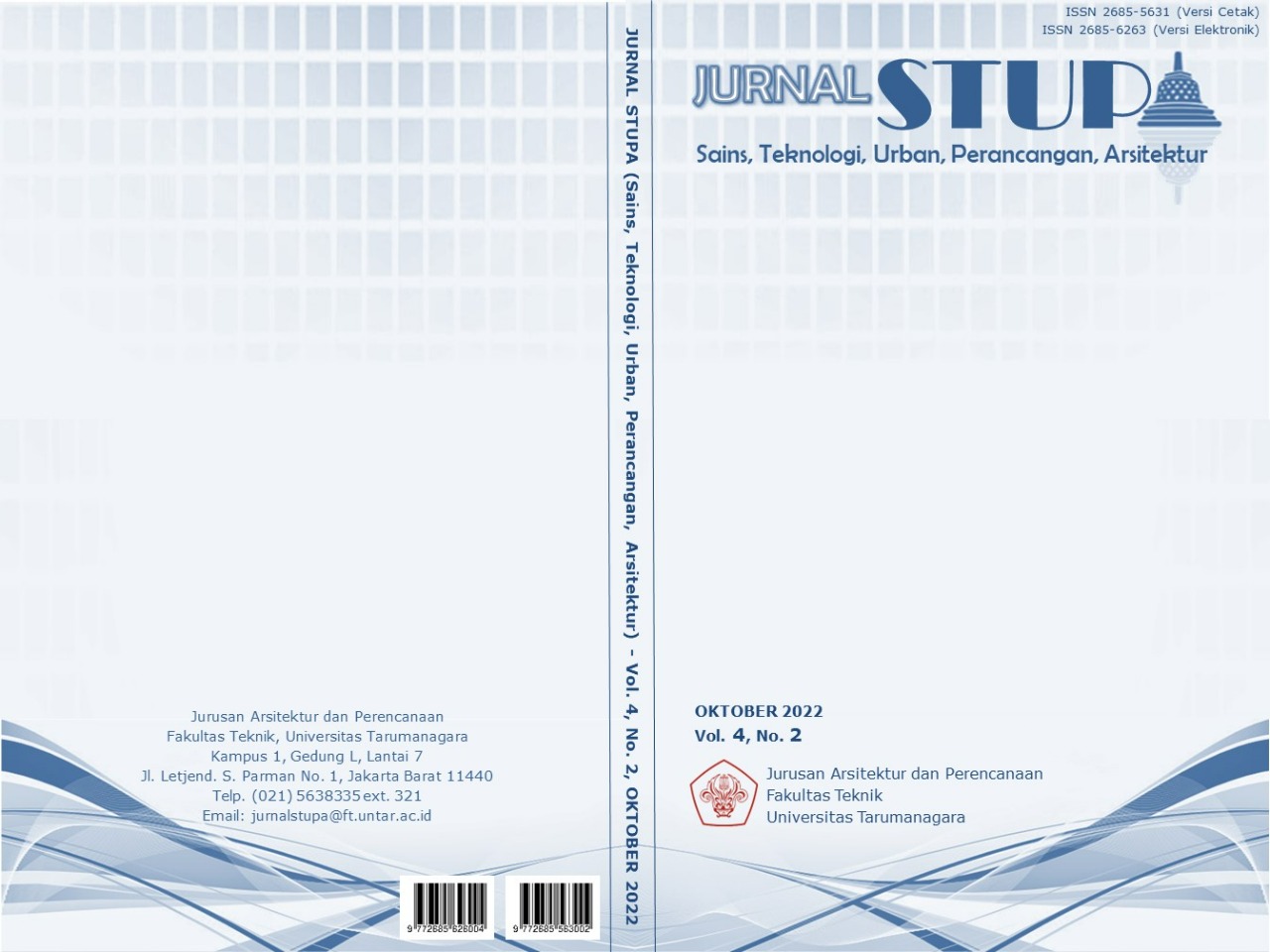PENDEKATAN SPACE SYNTAX DAN ARSITEKTUR KESEHARIAN SEBAGAI STRATEGI AKUPUNKTUR KOTA DI KAWASAN MUARA ANGKE
Main Article Content
Abstract
Muara Angke has great fishery and tourism potential, however, there are still many Muara Angke residents who have a low economy and lack of empowerment. The environment of Muara Angke also seems shabby because of the large amount of unprocessed waste scattered in this area. Clean water crisis also occurs where coastal residents find it difficult to meet their daily water needs. Urban acupuncture is an approach to provide urban spatial planning solutions in order to have a significant improvement impact in a short time. This study is needed to determine the appropriate urban acupuncture points, one of which is the space syntax and everday architecture method in determining the appropriate program for the Muara Angke. So that the design can determine the right program and point to achieve an increase in regional productivity along with improving the environmental quality of the Muara Angke. The data collection method is done by descriptive analysis and the method used in the design is the space syntax and everyday architecture method. This approach aims to read the area, determine the program, and space configuration in the design. Fish processing facilities program at the main point can increase economic productivity. Aligned with the water filtration module and the waste sorting post at the secondary point, that solves the clean water crisis and improves waste management in the area. Thus, the space syntax and everyday architecture approach in design can be a regeneration point for Muara Angke.
Keywords: Everyday Architecture; Muara Angke; Urban Acupuncture; Space Syntax
Abstrak
Muara Angke memiliki potensi perikanan dan wisata yang besar namun, masih banyak warga Muara Angke yang berekonomi rendah dan kurang pemberdayaan. Lingkungan Muara Angke pun terkesan kumuh karena banyaknya sampah tanpa pengolahan yang tersebar di kawasan ini. Krisis air bersih juga terjadi dimana warga pesisir kesulitan untuk memenuhi kebutuhan air sehari-hari. Akupunktur kota merupakan sebuah pendekatan untuk memberikan solusi penataan ruang kota agar mendapat dampak perbaikan secara signifikan dalam waktu yang singkat. Studi ini menentukan titik akupunktur kota yang tepat salah satunya dengan metode space syntax dan arsitektur keseharian dalam menentukan program yang sesuai untuk Kawasan Muara Angke. Agar perancangan dapat mementukan program dan titik yang tepat guna mencapai peningkatan produktivitas kawasan sejalan dengan peningkatan kualitas lingkungan Kawasan Muara Angke. Metode pengumpulan data dilakukan dengan analisis deskriptif dan metode yang digunakan pada perancangan adalah metode space syntax dan arsitektur keseharian. Pendekatan ini bertujuan untuk membaca kawasan, menentukan program, dan konfigurasi ruang pada rancangan. Program fasilitas pengolahan hasil laut pada titik utama dapat meningkatkan produktivitas ekonomi. Selaras dengan modul filtrasi air dan pos pemilahan sampah pada titik sekunder menyelesaikan masalah krisis air bersih dan memperbaiki manajemen limbah pada kawasan. Sehingga, pendekatan space syntax dan arsitektur keseharian dalam perancangan dapat menjadi titik regenerasi bagi Kawasan Muara Angke.
Article Details

This work is licensed under a Creative Commons Attribution-NonCommercial-ShareAlike 4.0 International License.
This work is licensed under a Jurnal Sains, Teknologi, Urban, Perancangan, Arsitektur/ STUPA Creative Commons Attribution-NonCommercial-ShareAlike 4.0 International LicenseReferences
Hillier. B. (2004). Space is The Machine. London: University of Cambridge.
Jormakka, K., Schurer, O., & Kuhlmann, D. (2007). Basic Design Method. Berlin: Birkhäuser Basel.
Lerner, J. (2016). Urban Acupuncture: Celebrating Principles of Change That Enrich City Life. Island press
Lefebvre, H. (1991). The Production of Space. United Kingdom: Wiley-Blackwell.
Mehrotra, R. (2005). Everyday urbanism: Margaret Crawford vs. Michael Speaks. Michigan: University of Michigan.
Nassar, U. (2021). Urban Acupuncture in Large Cities: Filtering Framework to Select Sensitive Urban Spots in Riyadh for Effective Urban Renewal. Journal of Contemporary Urban Affairs Vol.5, 1-18.
Pratama, S., & Priscilla E. (2020). Pendekatan Metode Desain Berbasis Perilaku Dalam Desain Proyek Pojok Hijau Citra 6. Jurnal Stupa, Vol. 2, No. 2, 1947-1956.
Sutanto, A. (2020). Peta Metode Desain. Jakarta: Universitas Tarumanagara



